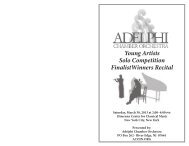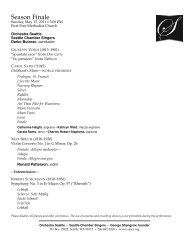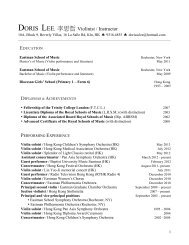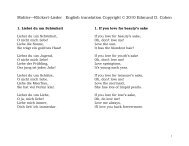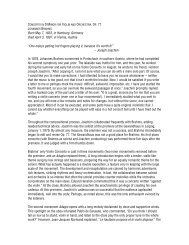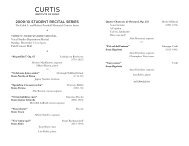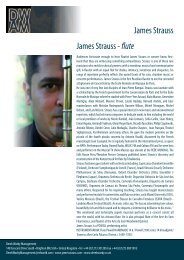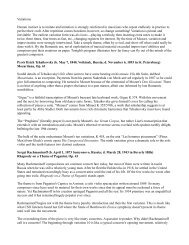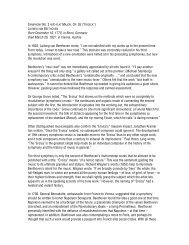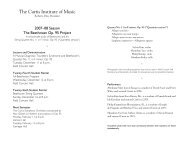Coriolan Overture, opus 62 Ludwig van Beethoven ... - InstantEncore
Coriolan Overture, opus 62 Ludwig van Beethoven ... - InstantEncore
Coriolan Overture, opus 62 Ludwig van Beethoven ... - InstantEncore
You also want an ePaper? Increase the reach of your titles
YUMPU automatically turns print PDFs into web optimized ePapers that Google loves.
Following a brief introduction, the music unfolds in two contrasting sections. The<br />
first is slow and smoldering in temperament. Over a dragging 4/4 beat, the violinist<br />
delivers elaborately embellished melodies featuring big melodic skips and many passages<br />
at the extreme top of the range to show off Sarasate's own remarkable technique. Finally,<br />
these embers blaze forth in a gypsy dance of high-speed pyrotechnics that tests the<br />
player's agility and accuracy to the max.<br />
Symphony No. 7 in A Major, <strong>opus</strong> 92<br />
<strong>Ludwig</strong> <strong>van</strong> <strong>Beethoven</strong><br />
<strong>Beethoven</strong>'s Seventh Symphony is one of the most extraordinary expressions of physical<br />
energy and joy in symphonic music. Completed in 1812, the Seventh, in the words of<br />
<strong>Beethoven</strong> biographer Maynard Solomon, “transports us into a sphere of laughter, play,<br />
and the exuberant release of bound energy.” This is a work without a shadow or a solemn<br />
thought or even a true slow movement — its well-loved Allegretto second movement<br />
only seems slow in comparison to its hyperkinetic companions. In any other hands, such<br />
unrelieved happiness might produce a feeling of triviality or monotony, but <strong>Beethoven</strong><br />
instead shows us the dynamic variety of joy.<br />
In an oft-quoted aphorism, composer Richard Wagner called the Seventh “the<br />
apotheosis of the dance,” a phrase more impressive than illuminating, for no movement<br />
here could be construed as a dance, except in the most abstract sense. More accurately,<br />
we might call this symphony “the apotheosis of rhythm.” Throughout <strong>Beethoven</strong>'s music,<br />
themes are as much characterized by their rhythmic patterns as by their melodic shapes or<br />
harmonic coloring. Here rhythm is the prime building block: the first, second, and fourth<br />
movements are all generated by one obsessive rhythmic figure announced at the opening;<br />
the third-movement scherzo has two such figures. <strong>Beethoven</strong> wields these rhythms with a<br />
display of unbridled energy and exuberance that shocked many of the Seventh's first<br />
listeners. Hearing the work at an early performance in conservative Leipzig, Friedrich<br />
Wieck, father of Clara Schumann, stated that <strong>Beethoven</strong> must have written it “in a<br />
drunken fury”!<br />
The Seventh was introduced to the world at a spectacular celebrity-studded<br />
concert on December 8, 1813 at the University of Vienna that was the most successful of<br />
<strong>Beethoven</strong>'s career. Organized by <strong>Beethoven</strong>'s friend Johann Nepomuk Maelzel, the<br />
inventor of the metronome, it was a benefit concert to raise money for soldiers wounded<br />
at the recent Napoleonic battle of Hanau. Both performers and audience were in high<br />
spirits for by this time it was clear that Napoleon's days were numbered. For the<br />
occasion, <strong>Beethoven</strong> had written one of his most notorious compositions, Wellington's<br />
Victory: a military extravaganza calling for vast troops of musicians and a huge<br />
percussion battery, manned by such luminaries as opera composer Giacomo Meyerbeer<br />
and piano virtuoso Ignaz Moscheles. In one of his last appearances as a conductor,<br />
<strong>Beethoven</strong> led the proceedings, but his deafness severely hampered his effectiveness. It is<br />
amazing the Seventh Symphony was even noticed in this circus atmosphere, but indeed it<br />
was warmly received and the audience demanded an encore of the second movement.<br />
The first movement begins with a slow introduction — the biggest <strong>Beethoven</strong><br />
ever wrote. Its expansive dimensions, accentuated by majestic rising scales, allows for<br />
two lyrical interludes — led first by oboes, then by the flute — which carry the music to



